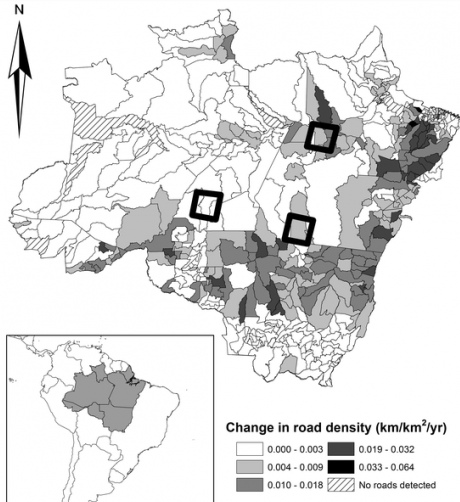Study of Brazilian Amazon shows 50,000 km of road was built in just three years
by Simon Levey

Nearly 17,000 kilometres of road were built in the Brazilian Amazon rainforest every year between 2004 and 2007.
Although road-building is a major contributor to deforestation and habitat loss, the way in which road networks develop is still poorly understood.
A new study is among the first to measure the number of roads built in a rainforest ecosystem over an extended period of time. It was published this month in the journal Regional Environmental Change by researchers including two Life Scientists from Imperial College London.
They say studies like this will help combat future deforestation by allowing for more accurate predictions of where it might occur.
Even though roads often occupy less than 2 per cent of a country's land surface, they may have an ecological impact on an area up to ten times as large. These indirect effects can include changes in air and soil temperature and moisture, as well as restrictions on the movement of animals.

Research co-author Dr Rob Ewers, of Imperial's Department of Life Sciences, said: "Knowing where the roads are and the speed at which they are built is key to predicting deforestation.
"A number of models currently exist which rely on this knowledge, but there are no good studies of how quickly roads get built and where they go when they are built.
"An understanding of road networks is the big missing gap in our ability to predict the future of this region."
Members of the research team used pre-existing road maps and satellite imagery to track the evolution of the Brazilian Amazon road network over a period of three years, in collaboration with IMAZON, the Amazon Institute of People and the Environment.
They found that road networks spread most quickly in regions with high economic growth, as well as in areas where new settlements were being built. Once a region had an extensive network of roads in place, however, the rate of building slowed down.
The researchers hope that these findings will improve our understanding of how land use is changing around the world, and help predict deforestation more accurately.
Dr Ewers is currently working on the SAFE (Stability of Altered Forest Ecosystems) project, one of the world's largest ecological experiments underway in Borneo.
He and his team will observe the planned logging of a tropical forest under controlled, experimental conditions. Careful observation of how the ecosystem becomes disrupted and breaks down when it is damaged will yield information crucial to future conservation efforts.
Dr Ewers spoke about the project to the Duke and Duchess of Cambridge when they travelled through south-east Asia in the summer of 2012. This work is funded by the Grantham Institute for Climate Change.
Journal reference
"Temporal patterns of road network development in the Brazilian Amazon" was published in Regional Environmental Change by Sadia E Ahmed, Carlos M Souza Jr, Júlia Riberio and Robert M Ewers. DOI: 10.1007/s10113-012-0397-z
Header image credit: Dr Toby Gardner.
Words by Gilead Amit -- Communications and Public Affairs.
Article text (excluding photos or graphics) © Imperial College London.
Photos and graphics subject to third party copyright used with permission or © Imperial College London.
Reporter
Simon Levey
Communications Division